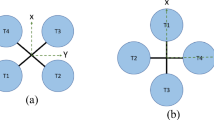Abstract
In recent years, quadcopter UAVs have been extensively utilized. Controlling quadcopters is a major concern, and researchers are actively studying it. In this study, altitude control of a quadcopter UAV is achieved using the symbolic limited optimal discrete controller synthesis technique. The resulting controller is compared with the adaptive PID control method, where the PID controller’s parameters are determined using the Dragonfly algorithm. The findings show the superior performance of our approach.






Similar content being viewed by others
Abbreviations
- SDCS:
-
Symbolic discrete controller synthesis
- DCS:
-
Discrete controller synthesis
- PID:
-
Proportional integral derivative
- DA:
-
Dragonfly algorithm
- UAV:
-
Unmanned aerial vehicle
- ITSE:
-
Integral of time squared error
- ISE:
-
Integral of squared error
- IAE:
-
Integral of absolute error
- ITAE:
-
Integral of time multiplied by absolute error
- DOF:
-
Degree of freedom
- Tr:
-
Rise time
- Tp:
-
Peak time
- Mp:
-
Maximum overshoot at peak time
- Ts:
-
Steady state time
- Ess:
-
Steady state error
- HDL:
-
Hardware description language
- MH:
-
Meta-heuristic
References
Yang X, Pei X (2022) Hybrid system for powering unmanned aerial vehicles: demonstration and study cases. In: Hybrid technologies for power generation. Elsevier, pp 439–473
Giordan D, Adams MS, Aicardi I, Alicandro M, Allasia P, Marco B, De Berardinis P, Dominici D, Godone D, Hobbs P et al (2020) The use of unmanned aerial vehicles (uavs) for engineering geology applications. Bull Eng Geol Environ 79(7):3437–3481
Sivakumar M, Malleswari TYJN (2021) A literature survey of unmanned aerial vehicle usage for civil applications. J Aerosp Technol Manag 13:66
Wang P, Man Z, Cao Z, Zheng J, Zhao Y (2016) Dynamics modelling and linear control of quadcopter. In: 2016 International conference on advanced mechatronic systems (ICAMechS). IEEE, pp 498–503
Thu KM, Gavrilov AI (2017) Designing and modeling of quadcopter control system using l1 adaptive control. Procedia Comput Sci 103:528–535
Leal IS, Abeykoon C, Perera YS (2021) Design, simulation, analysis and optimization of pid and fuzzy based control systems for a quadcopter. Electronics 10(18):2218
Taşören AE, Gökçen A, Soydemir MU, Şahin S (2020) Artificial neural network-based adaptive pid controller design for vertical takeoff and landing model. Avrupa Bilim ve Teknoloji Dergisi 66:87–93
Wong WK, Ming CI (2019) A review on metaheuristic algorithms: recent trends, benchmarking and applications. In: 2019 7th International conference on smart computing & communications (ICSCC). IEEE, pp 1–5
Mirjalili S (2016) Dragonfly algorithm: a new meta-heuristic optimization technique for solving single-objective, discrete, and multi-objective problems. Neural Comput Appl 27(4):1053–1073
Wang J-S, Ning C-X, Yang Y (2014) Multivariable pid decoupling control method of electroslag remelting process based on improved particle swarm optimization (pso) algorithm. Information 5(1):120–133
Meraihi Y, Ramdane-Cherif A, Acheli D, Mahseur M (2020) Dragonfly algorithm: a comprehensive review and applications. Neural Comput Appl 32(21):16625–16646
Ramadge PJG, Wonham WM (1989) The control of discrete event systems. Proc IEEE 77(1):81–98. https://doi.org/10.1109/5.21072
Marchand H, Samaan M (2000) Incremental design of a power transformer station controller using a controller synthesis methodology. IEEE Trans Softw Eng 26(8):729–741. https://doi.org/10.1109/32.879811
Marchand H, Bournai P, Le Borgne M, Le Guernic P (2000) Synthesis of discrete-event controllers based on the signal environment. Discrete Event Dyn Syst Theory Appl 10(4):325–346. https://doi.org/10.1023/A:1008311720696
Berthier N, Marchand H (2014) Discrete controller synthesis for infinite state systems with reax. IFAC Proc Vol 47(2):46–53. https://doi.org/10.3182/20140514-3-FR-4046.00099
Özbaltan M, Berthier N (2018) Exercising symbolic discrete control for designing low-power hardware circuits: an application to clock-gating. IFAC-PapersOnLine 51(7):120–126. https://doi.org/10.1016/j.ifacol.2018.06.289
Özbaltan M, Berthier N (2020) A case for symbolic limited optimal discrete control: Energy management in reactive data-flow circuits. IFAC-PapersOnLine 53(2):10688–10694. https://doi.org/10.1016/j.ifacol.2020.12.2842
Özbaltan M, Berthier N (2021) Power-aware scheduling of data-flow hardware circuits with symbolic control. Arch Control Sci 31(2):431–446. https://doi.org/10.24425/acs.2021.137426
Çaşka S, Uysal A (2021) İha yardımcı iniş sisteminin meta-sezgisel optimizasyon yöntemleri ile kontrolü. Afyon Kocatepe Üniversitesi Fen ve Mühendislik Bilimleri Dergisi 21(5):1223–1230
Funding
Not applicable.
Author information
Authors and Affiliations
Contributions
All authors contributed equally to this work.
Corresponding author
Ethics declarations
Conflict of interest
Not applicable.
Code or data availability (software application or custom code)
Not applicable.
Rights and permissions
Springer Nature or its licensor (e.g. a society or other partner) holds exclusive rights to this article under a publishing agreement with the author(s) or other rightsholder(s); author self-archiving of the accepted manuscript version of this article is solely governed by the terms of such publishing agreement and applicable law.
About this article
Cite this article
Özbaltan, M., Çaşka, S. Altitude control of quadcopter with symbolic limited optimal discrete control. Int. J. Dynam. Control 12, 1533–1540 (2024). https://doi.org/10.1007/s40435-023-01278-3
Received:
Revised:
Accepted:
Published:
Issue Date:
DOI: https://doi.org/10.1007/s40435-023-01278-3




